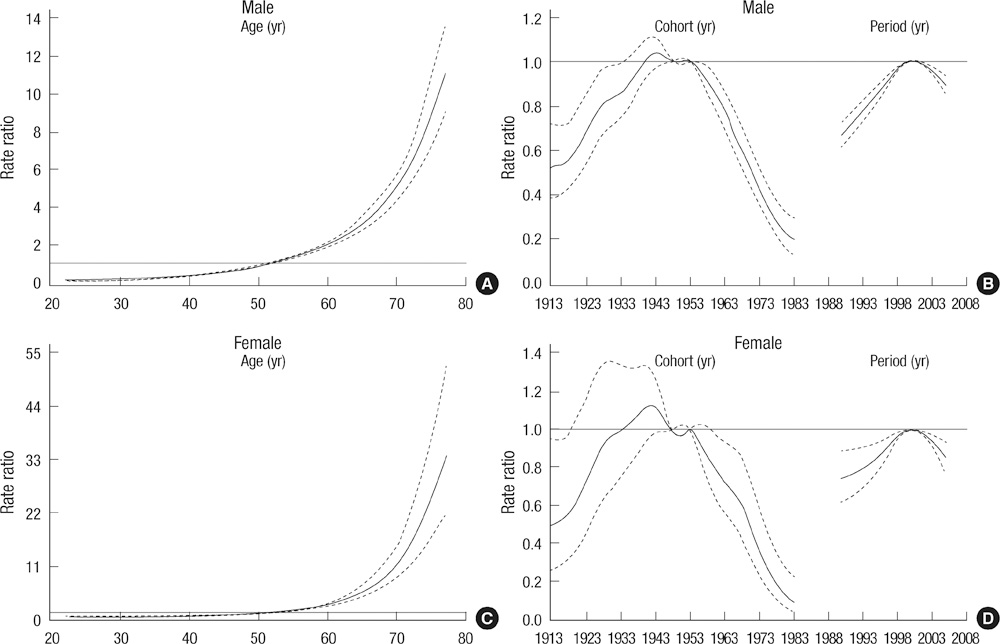J Korean Med Sci.
2011 May;26(5):637-641. 10.3346/jkms.2011.26.5.637.
Time Trend and Age-Period-Cohort Effects on Acute Myocardial Infarction Mortality in Korean Adults from 1988 to 2007
- Affiliations
-
- 1Center for Interventional Pain Management, Daejeon Woori Hospital, Daejeon, Korea.
- 2Department of Biostatistics, School of Public Health, Seoul National University, Seoul, Korea.
- 3Department of Epidemiology, School of Public Health, Seoul National University, Seoul, Korea. scho@snu.ac.kr
- KMID: 1777862
- DOI: http://doi.org/10.3346/jkms.2011.26.5.637
Abstract
- We examined time trend and age-period-cohort effects on acute myocardial infarction (AMI) mortality in Korean adults from 1988 to 2007. Annual AMI mortality data and population statistics from 1988 to 2007 were obtained from the STATISTICS KOREA website. Age adjusted mortality for four 5-yr calendar periods (1988-1992 to 2003-2007) was calculated by direct standardization using the Year 2000 WHO world standard population. A log-linear Poisson regression model was used to estimate age, period, and cohort effects on AMI mortality. In both genders, age-adjusted AMI mortality increased from period one (1988-1992) to period three (1998-2002) but decreased in period four (2003-2007). An exponential age effect was noted in both genders. The rate ratio of the cohort effect increased up to the 1943 birth cohort and decreased gradually thereafter, and the rate ratio of the period effect increased up to period three (1998-2002) and decreased thereafter. Our results suggest that AMI mortality in Korean adults has decreased since the period 1998-2002 and age, period, and cohort effects have influenced on AMI mortality.
Keyword
MeSH Terms
Figure
Cited by 1 articles
-
Changes in the Characteristics and Long-term Mortality Rates of Intensive Care Unit Patients from 2003 to 2010: A Nationwide Population-Based Cohort Study Performed in the Republic of Korea
Jeongwon Heo, Yoonki Hong, Seon-Sook Han, Woo Jin Kim, Jae-Woo Kwon, Ki Won Moon, Jae Hoon Jeong, Young-Ju Kim, Seung-Hwan Lee, Seung-Joon Lee
Acute Crit Care. 2018;33(3):135-145. doi: 10.4266/acc.2018.00164.
Reference
-
1. Statistical Fact Sheet - Populations: 2009 Update. American Heart Association. accessed on 1 Mar 2011. Available at http://www.americanheart.org/downloadable/heart/1236204012112INTL.pdf.2. Economic statistics system. The Bank of Korea. accessed on 1 Mar 2011. Available at http://ecos.bok.or.kr/.3. Mortality statistics and causes of death in Korea, 2008. Statistics Korea. accessed on 1 Mar 2011. Available at http://www.nso.go.kr/nso2006/k04___0000/k04b__0000/k04ba_0000/k04ba_0000.html?method=view&board_id=144&seq=85&num=85.4. Li YJ, Rha SW, Chen KY, Jin Z, Minami Y, Wang L, Dang Q, Poddar KL, Ramasamy S, Park JY, Oh DJ, Jeong MH. Korea Acute Myocardial Infarction Registry Investigators. Clinical characteristics and mid-term outcomes of acute myocardial infarction patients with prior cerebrovascular disease in an Asian population: lessons from the Korea Acute Myocardial Infarction Registry. Clin Exp Pharmacol Physiol. 2010. 37:581–586.5. Sim DS, Jeong MH, Kang JC. Current management of acute myocardial infarction: experience from the Korea Acute Myocardial Infarction Registry. J Cardiol. 2010. 56:1–7.6. Hong JS, Kang HC, Lee SH, Kim J. Long-term trend in the incidence of acute myocardial infarction in Korea: 1997-2007. Korean Circ J. 2009. 39:467–476.7. Robertson C, Boyle P. Age-period-cohort analysis of chronic disease rates. I: Modelling approach. Stat Med. 1998. 17:1305–1323.8. Choi Y, Kim Y, Hong YC, Park SK, Yoo KY. Temporal changes of lung cancer mortality in Korea. J Korean Med Sci. 2007. 22:524–528.9. Kwon JW, Song YM, Park H, Sung J, Kim H, Cho SI. Effects of age, time period, and birth cohort on the prevalence of diabetes and obesity in Korean men. Diabetes Care. 2008. 31:255–260.10. Ahmad OB, Boschi-Pinto C, Lopez AD, Murray CJ, Lozano R, Inoue M. Age standardization of rates: a new WHO standard. accessed on 1 Mar 2011. Available at http://www.who.int/healthinfo/paper31.pdf.11. Holford TR. The estimation of age, period and cohort effects for vital rates. Biometrics. 1983. 39:311–324.12. Holford TR. Understanding the effects of age, period and cohort on incidence and mortality rates. Annu Rev Public Health. 1991. 12:425–457.13. Carstensen B. Age-Period-Cohort models: Statistical inference in the Lexis diagram. accessed on 1 Mar 2011. Available at http://staff.pubhealth.ku.dk/~bxc/Lexis/Lexis.pdf.14. Roger VL, Jacobsen SJ, Weston SA, Bailey KR, Kottke TE, Frye RL. Trends in heart disease deaths in Olmsted County, Minnesota, 1979-1994. Mayo Clin Proc. 1999. 74:651–657.15. Gerber Y, Jacobsen SJ, Frye RL, Weston SA, Killian JM, Roger VL. Secular trends in deaths from cardiovascular diseases: a 25-year community study. Circulation. 2006. 113:2285–2292.16. Ma E, Iso H, Takahashi H, Yamagishi K, Tanigawa T. Age-Period-Cohort analysis of mortality due to ischemic heart disease in Japan, 1955 to 2000. Circ J. 2008. 72:966–972.17. Yu IT, Li W, Wong TW. Effects of age, period and cohort on acute myocardial infarction mortality in Hong Kong. Int J Cardiol. 2004. 97:63–68.18. White HD, Barbash GI, Califf RM, Simes RJ, Granger CB, Weaver WD, Kleiman NS, Aylward PE, Gore JM, Vahanian A, Lee KL, Ross AM, Topol EJ. Age and outcome with contemporary thrombolytic therapy. Results from the GUSTO-I trial. Global Utilization of Streptokinase and TPA for Occluded coronary arteries trial. Circulation. 1996. 94:1826–1833.19. Barakat K, Wilkinson P, Deaner A, Fluck D, Ranjadayalan K, Timmis A. How should age affect management of acute myocardial infarction? A prospective cohort study. Lancet. 1999. 353:955–959.
- Full Text Links
- Actions
-
Cited
- CITED
-
- Close
- Share
- Similar articles
-
- The One-Year Prognostic Value of the Pre-Discharge ECG after the First Acute Myocardial Infarction
- Trends in Ischemic Heart Disease Mortality in Korea, 1985-2009: An Age-period-cohort Analysis
- Can time delay be shortened in the treatment of acute myocardial infarction?: Experience from Korea acute myocardial infarction registry
- The Trend in Incidence and Case-fatality of Hospitalized Acute Myocardial Infarction Patients in Korea, 2007 to 2016
- Serum Myoglobin in the Early Phase of Acute Myocardial Infarction



